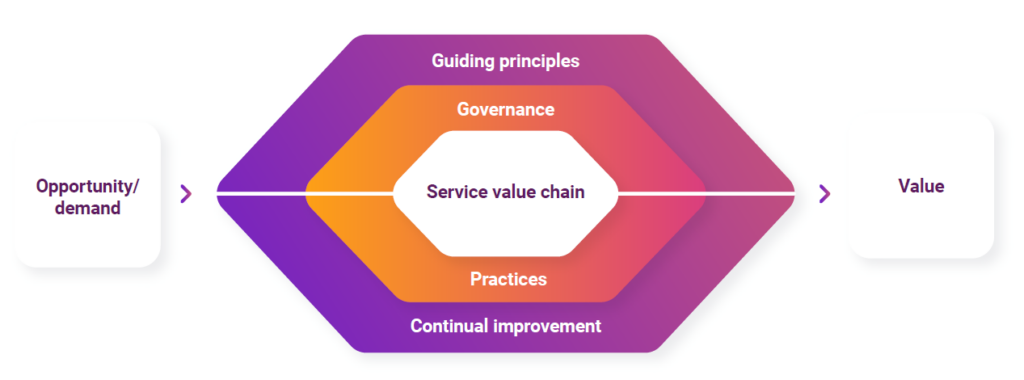ITIL stands for Information Technology Infrastructure Library, and as the name doesn’t suggests, it is a set of recommendations for delivering value to its customer, through IT products or services.
In concrete terms, ITIL formalises many things that are common sense but that it is good to keep in mind in a service provision approach. It is a reference base, which is mandatory, particularly for ITSM software that will be used to provide service support. Respecting ITIL allows you to optimise your customer service processes and the gains are numerous:
- Time saving
- Cost reduction
- More precise definition of roles and responsibilities
- Improved user satisfaction
- Improved productivity
- Better quality of IT services
- Adaptation to change
4 dimensions, 7 guiding principles
Firstly, the ITIL recommendations are based on 4 dimensions:
- Organization and people
- Technology and information
- Suppliers and partners
- Value Stream and Processes
Above all, ITIL consists of 7 major guiding principles that should be applied as much as possible to each service management activity:
- Focus on value
- Start where you are
- Progress iteratively with feedback
- Think and work holistically
- Collaborate and promote visibility
- Keep it simple and practical
- Optimise and automate
These principles are not unlike the Agile manifesto or even DevOps. Indeed, everything is linked and follows the same logic of conceiving work together in the world of technology: Agile for project management, DevOps for the life cycle of an application, and ITIL for service management.
The service value system and ITIL practices

The service value system is a simple representation of the activities involved in the value creation process, from demand or opportunity to the value provided by the service. In between, the value chain explained below is surrounded by :
- the guiding principles that should never be forgotten in any service creation activity
- the governance of the organisation, how it is managed, controlled
- the ITIL practices, which describe all the activities involved in service management
- and continuous improvement, to be applied to any activity.
The value chain explains the process of creating value from a demand

It starts with a first step to ensure the commitment and understanding of all stakeholders. Customers, suppliers, employees, etc. Then it is a service or product that will deliver the expected value. This product or service may have to be created, corrected, maintained, or simply executed. Indeed, a request may require the complete development of a new product, but also the support of an existing product. Around this, continuous improvement is recommended, as well as the planning of actions.
This chain can be used to create a value stream for each demand.
All this brings us (finally) to ITIL practices, concrete service related activities, explained by consensus (not here, that would be a bit long!):
General management practices
- Strategy management
- Portfolio management
- Architecture management
- Service financial management
- Workforce and talent management
- Continual improvement
- Measurement and reporting
- Risk management
- Information security management
- Knowledge management
- Organizational change management
- Project management
- Relationship management
- Supplier management
Service management practices
- Business analysis
- Service catalogue management
- Service design
- Service level management
- Availability management
- Capacity and performance management
- Service continuity management
- Monitoring and event management
- Service desk
- Incident management
- Service request management
- Problem management
- Release management
- Change enablement
- Service validation and testing
- Service configuration management
- IT asset management
Technical management practices
- Deployment management
- Infrastructure and platform management
- Software development and management

Our latest study of ITSM (Information Technology Service Management) and ESM (Enterprise Service Management) goes into more detail on the presentation of the ITIL recommendations, and proposes an analysis of the ITSM / ESM market. This document aims to help understand the positioning of each in order to make the right choice, after having explained the concepts addressed by this software market.
Spectrum Benchmark ITSM / ESM, 2023 Edition is available for free download.


